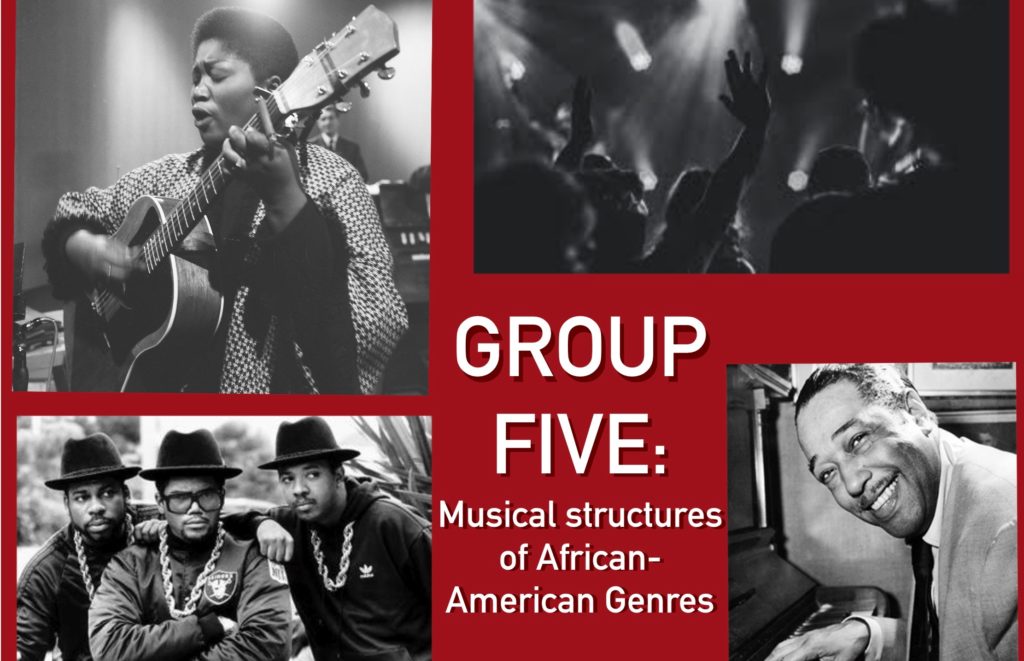Musical Structures of African-American Genres
by: Jordan Bishop, Janelle Clark, Bahi Iboaya, Sierra Foster
Gospel
by: Jordan Bishop
“Don’t let the Devil steal the beat from the Lord! The Lord doesn’t like us to act dead. If you feel it, tape your feet a little – dance to the glory of the Lord.” Mahalia Jackson
The production or performances within Gospel services has transformed and shaped the musical engagement amongst social gatherings. The use of extreme body movement reflected emotional expression and unification between oneself and the song; African societies encouraged this form of physical engagement because it inspired group interaction. Though their movement was criticized and mocked, their actions being labeled as “weird” and “strange” has transformed to inspire various musical artists within today’s society to seek this form of enjoyment and validation amongst their audience.
Rap
by: Sierra Foster
Rap was seen as a new, explosive trend around the time of the mid 1970s that expressed the great verbal creativity of the African Americans, with them opening the world up to this type of musicality that had never been seen before. The rap at its earlier time had included human beatboxing, which was seen as a type of vocal percussion and oral instrument done by the performers. Rap included numerous different structures, which made it so unique such as texture, call-response, rhythm, as well as, improvisation. The texture aspect of this genre proved to be different in its element with the scratching of the turntables by the DJ, or disc jockey, which created the “buzzy texture” as stated in the text. The call-response had been an element used in many genres that were established earlier but in rap it was mostly utilized by the MCs or rappers to engage the crowd in a performance. The use of improvisation was also necessary in the structure of rap with the rise of freestyle that most of the rap performances consisted of. All of these elements that were critical in structuring the genre of rap were utilized in consideration of maintaining the rhythm of the overall sound of this intricate genre.
Folk Music
text and pitch
by: Janelle Clark
The singing styles of folk music are story based and in long, loud tunes. The way in which folk music sounds is crucial to the context of each song, adding to the feeling and intention of the song. Composed of different instruments, vocals, and percussion, folk music is a multifaceted genre. The mechanics of text and pitch in folk music depends on the story the song is telling. The context will determine what type of tone the song will take. In Fast Car by Tracy Chapman, though more modern, the passionate vocals describe the hard luck life of a young person. The journey is told with soft instrumentals, accompanied by a gentle voice, until the passionate and exciting chorus that regales the freedom they have when they “finally see what it means to be living.” Like Chapman, Odetta Holmes is a folk music icon who used her powerful voice and unique singing style to make folk music. In her song Jumping Judy, the jaunty tune amplifies her strong vocals to further assist in the storytelling of the song. As demonstrated in the songs the pitch and text work strongly in folk music, the genre would not be the same without this vital musical structure.
Jazz
Sound Quality (Timbre) and Style of Delivery
by: Bahi Iboaya
“Perhaps the most noticeable feature in African and African American music is its rhythmic complexity.” (13)
“Rhythm is to the African what harmony is to the Europeans and it is the complex interweaving of contrasting rhythmic patterns that he finds his greatest aesthetic satisfaction” (A.M. Jones)
Rhythm isn’t organized singularly but in both linear and multilinear forms and must be noted that in black music rhythm assumes a “hierarchical position over melody.” Polyrhythm, which is the simultaneous use of two or more rhythms which are not derived from one another is “ubiquitous to sub Saharan African instrumental ensembles” made up of various percussive and melodic instruments of various timbres. A prominent example of this is expressed through the genre of jazz, which oftentimes utilizes polyrhythms as they are a key rhythmic component to the genre. In addition another key rhythmic component to this genre is timbre. The timbre of jazz can be very broad depending on the type of jazz music, however the overall timbre of jazz can be described as raspy, edgy, warm, and light. Distinctive and contrasting timbres characterize performances of jazz.


